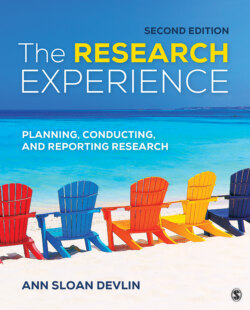Читать книгу The Research Experience - Ann Sloan Devlin - Страница 91
What to Do With Your Articles (Read More Than the Abstract!)
ОглавлениеIf you develop a research idea by only reading abstracts, the quality of your research project will suffer. An Abstract of 250 or fewer words does not provide sufficient detail to make decisions related to your project. You need to read beyond the Abstract to determine the paper’s true relevance to your idea. You may find it useful to start with the Method and Discussion sections before reading the other sections of the paper. Many of the important details come in the section that describes how the research was done, known as the Method section. This section includes the “who” (the participants and their number), the “what” (the measures/equipment), and the “how” (the procedure). You can quickly see the nature and scope of the undertaking and consider its relevance to your circumstances (in terms of participants, measures, and/or equipment). The Discussion reports whether the hypotheses were supported, connects the findings to the literature on the topic, acknowledges limitations, and gives some ideas for future directions. The description of the limitations and presentation of future directions both may help shape your research idea.
Method: Heading in American Psychological Association (APA) research paper in which you present your Participants, Materials/Measures/Instruments, and Procedure.
Discussion: Title of section in a manuscript when you interpret the results, centered and bolded in American Psychological Association (APA) style.
How many articles do you need to read? There is no firm number, but in reading between 20 and 30 articles, you will become increasingly familiar with the topic and will begin to see the same articles cited again and again. When this happens, you have begun to identify the important publications in the field; these should serve as a foundation for your work.
Many articles you read will follow APA publication style. If that is the case, the articles will be divided into (a) a review of the literature, (b) a method section (with subsections dealing with participants, measures, and procedure), (c) the findings (Results), and (d) the meaning of the work (Discussion). The section heading labels may differ somewhat depending on the nature of the research consulted (e.g., quantitative, qualitative, mixed methods).
Figure 2.11 Overview of Connections to Resources Available Through Your Library
Source: Adapted from Devlin (2006), p. 29, Figure 1.3.
